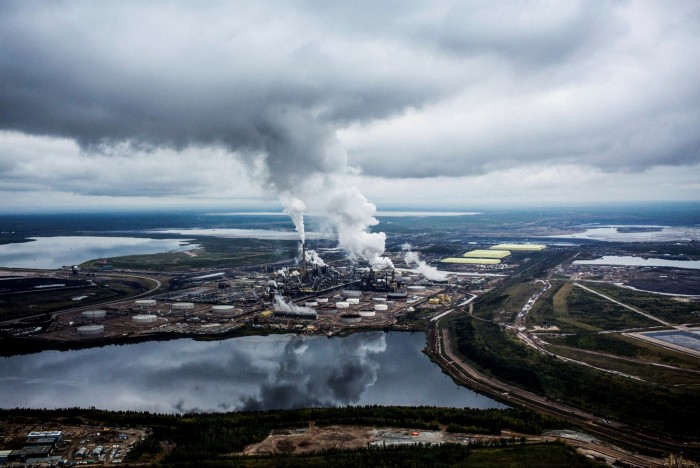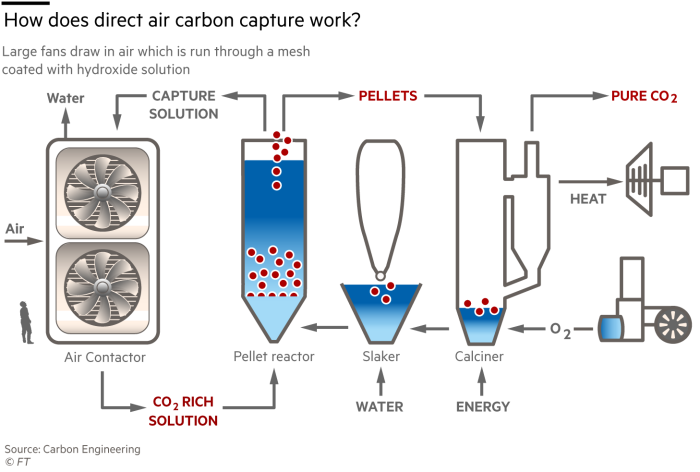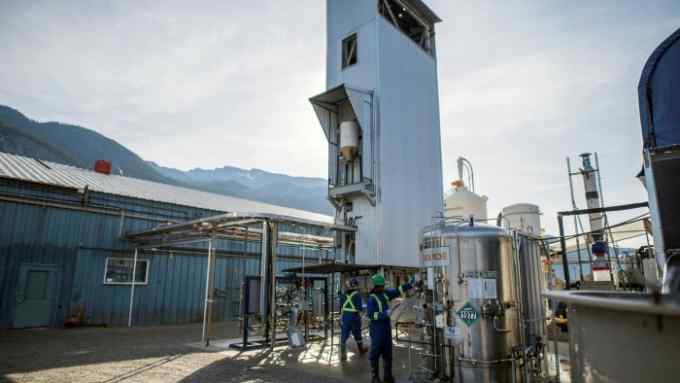Clean tech offers breath of fresh air for carbon-reliant Canada

Roula Khalaf, Editor of the FT, selects her favourite stories in this weekly newsletter.
Ask environmentalists about the Canadian province of Alberta and they will almost certainly mention the oil sands: a 50,000 square mile area with 165bn barrels of crude reserves — the third largest, globally, behind those of Venezuela and Saudi Arabia.
Dubbed “the world’s most destructive oil operation” by National Geographic magazine, the site has long been deemed a blight on Canada’s environmental record. It also hampers the country’s green ambitions, as oil sands extraction results in high greenhouse gas emissions.
Yet Carbon Engineering, a start-up that has raised $110m in funding and is backed by philanthropist Bill Gates, believes it can burnish Canada’s green reputation by sucking carbon dioxide out of the air.
Based in Squamish, a mountain town in British Columbia, the tech group’s pilot facility has been removing CO2 from the atmosphere since 2015. It says that each of its “direct air capture” facilities can extract 1m tonnes of CO2 a year, “equivalent to the annual emissions of 250,000 average cars or the work of 40m trees”.

Steve Oldham, Carbon Engineering’s chief executive, now believes he can scale up its business in Alberta and neighbouring Saskatchewan, where geological features provide “some of the best locations in the world” to safely house “decades worth of the world’s carbon emissions”.
His business plan is simple: as companies seek to go carbon-neutral, they pay Carbon Engineering to offset their emissions, or even go carbon-negative.
The group says it expects to achieve costs of “less than $100 a tonne” for its carbon capture — below the International Energy Agency’s estimates of $135-$345 a tonne for other capture technologies.

Simpler methods, such as tree planting, can cost as little as $10 a tonne. But Oldham believes there will be demand for hundreds of direct air capture facilities. “A country like Canada can offer this service to the world in the same way that the Middle East offers oil to the world,” he argues.
Since 2017, Carbon Engineering has also been converting captured carbon into a synthetic crude, which can be used in making petrol, diesel or jet fuel.
The group gained its first paying client this year when Shopify, an Ontario ecommerce platform, paid an undisclosed sum for 10,000 tonnes of “permanent carbon dioxide removal” through a Carbon Engineering facility.
Carbon Engineering’s key technology continuously absorbs CO2 through chemical processes, and was developed from an original idea by David Keith, a Canadian professor at Harvard who founded the group in 2009 while teaching at the University of Calgary.
It is now one of several carbon-focused Canadian tech groups. Another is Planetary Hydrogen, a Nova Scotia group that takes CO2 from the ocean and turns it into green hydrogen. A third is CarbonCure, also from Nova Scotia, which uses captured CO2 as a building block to produce concrete. In April, it shared the top honour in the $20m Carbon XPrize competition, which recognises innovation in carbon conversion technology.
All three companies have also received kickstart support from Shopify’s sustainability fund. Stacy Kauk, director of the fund, says it overpays for emerging products “so that companies can buy equipment, or secure other things like facilities and labs and senior experts”.
And it is Canada’s oil industry expertise that is now helping to find the best ways to best pump and store CO2 emissions underground.
“Our knowledge of geology, well management and pipeline control is going to be very important as we transition out of oil and gas,” Kauk says.
“Those pipelines are going to be used to carry things like renewable natural gas that’s captured from landfills. It’s going to be used to carry hydrogen; we’re going to be reverse engineering those wells to put CO2 back in the ground. That’s well paired with the historical oil and gas efforts in Canada.”
While Shopify’s sustainability fund is small, at just $5m, the fact that it does not take an equity stake in the groups it backs has stoked venture capital interest in its projects.
Bill Gates is Carbon Engineering’s highest-profile investor but its biggest funding has come from the venture capital arms of the Big Oil groups, Occidental Petroleum and Chevron.
Carbon capture is, however, a contentious technology. Greenpeace calls it a “false hope” because it might only serve to extend the world’s dependence on fossil fuels.
Oldham says that while the rise of electric vehicles and renewable energy will prevent more CO2 from being released into the atmosphere, “no amount of electric cars are going to solve yesterday’s emissions”.
“Even if we stop all carbon emissions tomorrow, we have to deal with legacy emissions,” he says.
Twice weekly newsletter

Energy is the world’s indispensable business and Energy Source is its newsletter. Every Tuesday and Thursday, direct to your inbox, Energy Source brings you essential news, forward-thinking analysis and insider intelligence. Sign up here.

Comments